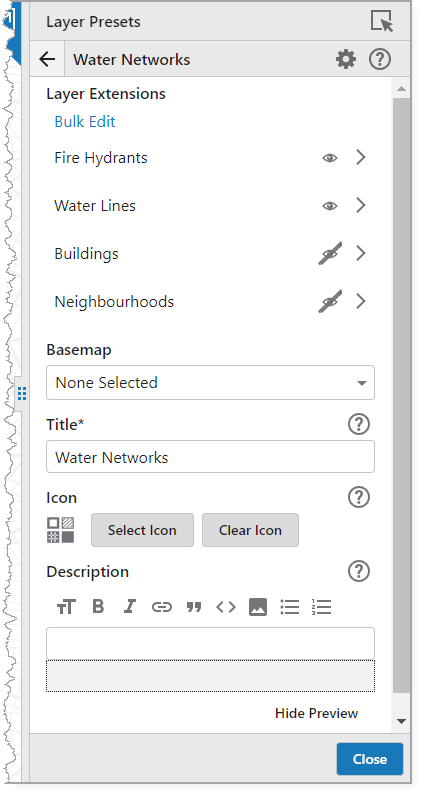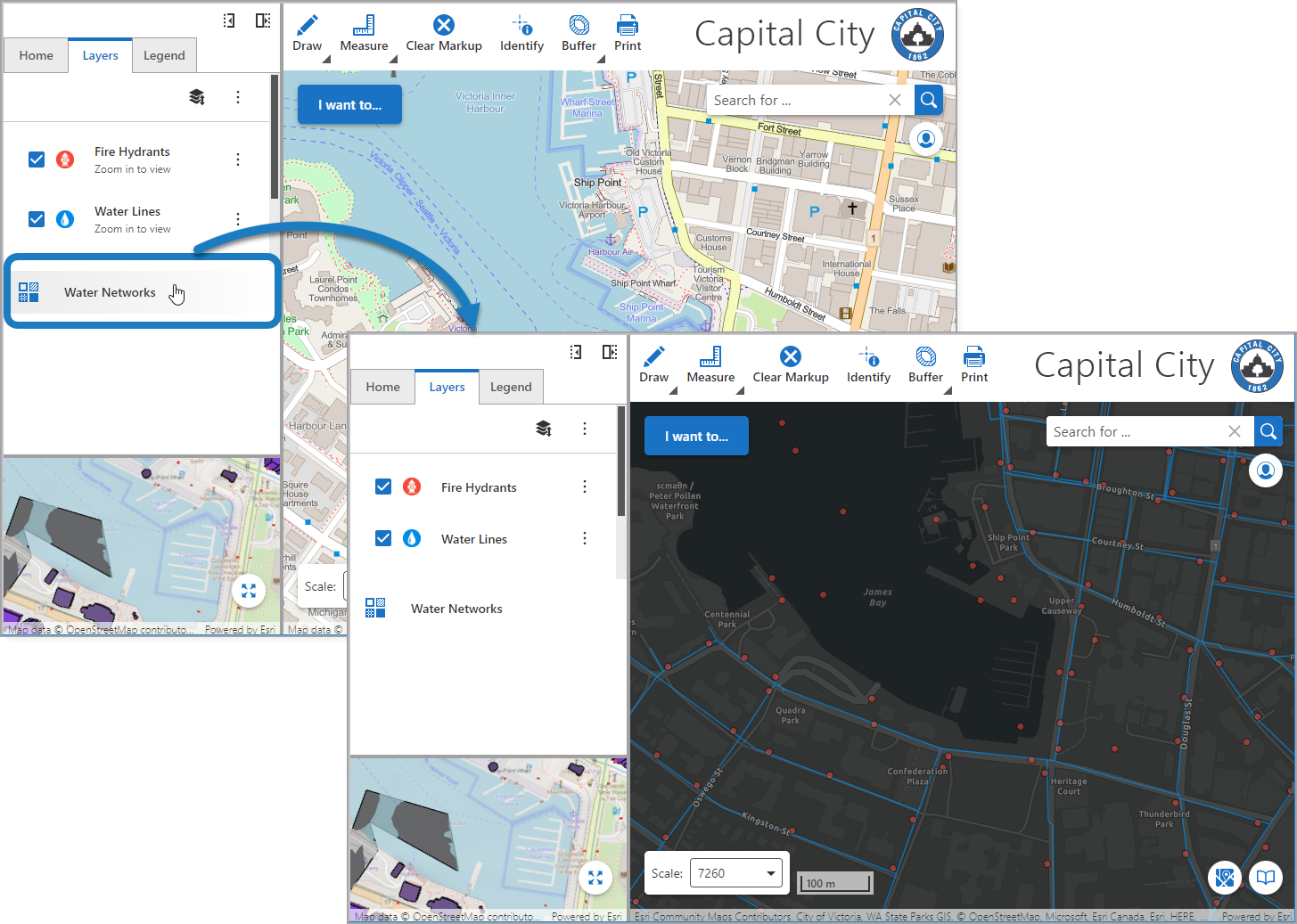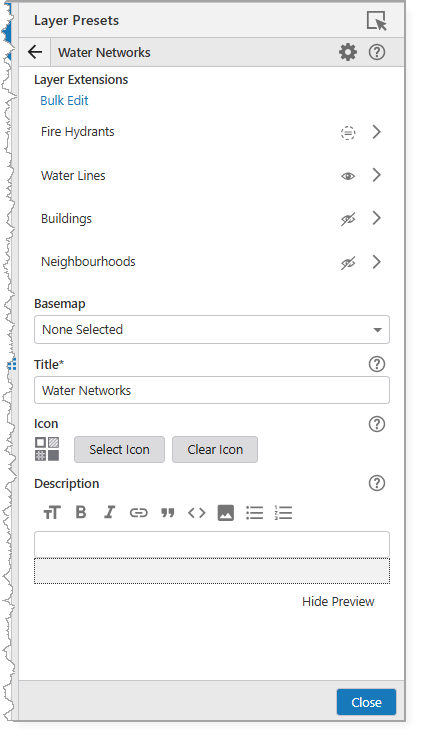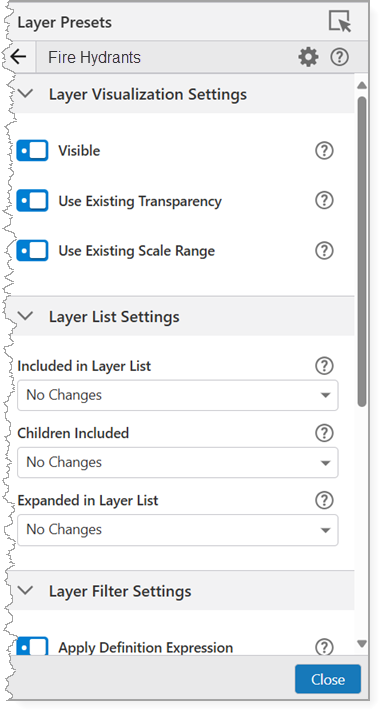With the Layer Presets component, you can create tailored views of your map data to highlight information of interest for your user. An advantage of configuring a layer preset is that you need to customize and maintain only one app that has many layers, instead of creating a new web app.
Examples of what you can configure in a layer preset are as follows:
•Apply a new basemap to put the most effective background behind the data you want to emphasize.
•Show/hide layers in the layer list to direct your user's focus on the relevant layers.
•Change the transparency of certain layers so specific data is still visible while the key data is more prominent.
•Change the scale visibility of certain layers to control what data your user can see at specific zoom levels.
These are the best practices to follow if you want to edit a layer preset.
You can also import a layer preset from Portal, making it easier to migrate complex configurations without manually rebuilding them.
Create a Layer Preset
The procedure below shows you how to create a layer preset. As our example, we create a layer preset called "Water Network". When the user selects this preset, all fire hydrants and water lines appear on the map and remain visible regardless of how far out the user zooms.
When you create a layer preset, you may want to also create a default preset that resets the view back to its original state.
To create a layer preset:
1.Open the Layer Presets settings and click Add Layer Preset.
2.Enter a Title for the preset and click Submit. In our example, we name our preset "Water Networks".
The settings open for the new layer preset.
3.In the Layer Extensions section, toggle the layers you want to show/hide by clicking the Visibility icon (![]() ). In our example, we want to make the Fire Hydrants and Water Lines layers visible and hide the Buildings and Neighbourhoods layers.
). In our example, we want to make the Fire Hydrants and Water Lines layers visible and hide the Buildings and Neighbourhoods layers.
To apply a visibility setting to multiple layers at the same time, click Bulk Edit.

4.Select each visible layer extension and configure the settings described in the table below.
Field |
Description |
|---|---|
Visibility |
Determines whether the layer is visible on the map. The options are as follows: •No Changes: Leaves the layer’s current visibility state unchanged. The No Changes option is the most flexible. It allows you to apply a preset to manage a group of layers without affecting other layers a user may have manually enabled. This is especially useful if you want your layer presets to apply definition expressions to certain layers but leave all other layers untouched. •Visible: Forces the layer to be visible when the preset is applied. •Not Visible: Forces the layer to be hidden when the preset is applied. |
Use Existing Transparency |
When enabled, the layer's current transparency remains unchanged (on). When disabled, you can manually adjust the transparency percentage to blend layers (100 is fully transparent and 0 is fully opaque). |
Use Existing Scale Range |
When enabled, the layer's current scale range remains unchanged (on). When disabled, you can manually adjust the following: •Maximum Scale: The scale at which your user cannot zoom in further. Setting this value to 0 allows your user to over-zoom layer tiles. •Minimum Scale: The scale at which your user cannot zoom out further. Setting this value to 0 allows your user to zoom out as far as possible. |
Included in Layer List |
Determines whether this layer appears in the Layer List. This does not affect the visibility of this layer on the map. The options are as follows: •No Changes: Leaves the layer’s current state unchanged. •Visible: Forces the layer to be included in the Layer List. •Not Visible: Forces the layer to be hidden from the Layer List. |
Apply Definition Expression |
When enabled, you can enter a definition expression to apply specific filter conditions to the preset layer. |
Definition Expression |
This field only appears if Apply Definition Expression is enabled. Enter your query definition (for our example, STATUS='Active' to show only the active fire hydrants and water lines). You can use the Filter Builder or Query Builder to build the definition. Switch it to Advanced Mode, copy the SQL syntax, and paste it into the Layer Preset's Definition Expression field. |
In our example, we configure the Fire Hydrants and Water Lines layer extension settings as follows:
|
|
5.Click Back (![]() )to return to the settings for the layer preset.
)to return to the settings for the layer preset.
6.Select a Basemap that emphasizes your data. For our example, we use Dark Gray Canvas.
7.Save your app.
When your user selects the configured layer preset, Web automatically applies the settings to the current layer.
The figure below shows the before and after of our Water Networks layer preset.

Best Practices to Edit a Layer Preset
Changes made to a web map after creating a layer preset can affect how that preset behaves.
To keep configurations aligned and avoid unexpected results, follow the best practices described in the table below.
Best Practice |
Description |
|---|---|
Save the web map before editing presets. |
Ensures that all updates are captured and available to the app. |
Refresh App Designer after making map changes. |
Reloads the latest map configuration into App Designer so presets stay in sync. |
Save App Designer after refresh. |
Ensures the refreshed configuration is committed and available the next time you open App Designer. |
Open each preset after making any layer changes. |
Verifies that layers, sublayers, and settings are still correctly applied. |
Wait for the app to fully load before editing presets. |
Prevents partial loading issues that can cause missing or misaligned layers. |
Avoid null or undefined sublayer titles. |
Reduces errors in preset mapping. Make sure you use clear, consistent names. |
Reset the configuration for renamed or re-added layers. |
If you add, remove, or rename layers and sublayers so that they no longer match the preset configuration, you must reopen the preset and manually update the settings. |
Import a Layer Preset from Portal
Layer presets must be created in VertiGIS Studio Desktop and published to Portal before you can import them into Studio Web.
To import a layer preset:
1.Open the Layer Presets settings and click the dropdown beside Add Layer Preset.
2.Click Add Layer Presets from Portal.
The Select Items window opens.
3.Locate the layer preset in your ArcGIS Online or ArcGIS Enterprise Portal.
You can select multiple items and import them in bulk.
4.Click Select to add the items.
The imported items appear in your list of available Layer Presets.
If a layer referenced in the imported layer preset does not exist in the web map of your current app, its configuration is ignored when you activate the layer preset.
If a layer in your web map is not referenced in the imported layer preset, its configuration is set to the default values shown below.
|
|



